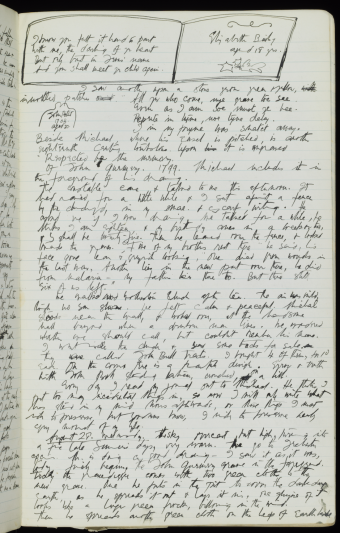Jonathan Hopson, Librarian, writes: Elizabeth Fitzgerald (known as ‘Duffy’) trained at the Central School of Art, where she met the painter Michael Rothenstein. They married in 1936 and eventually settled in Great Bardfield, Essex, where they became members of the artists’ community which gained national renown in the 1950s through a series of large open-house exhibitions. Her own career was initially subordinated to supporting Rothenstein. However, after their divorce in 1956, she married the graphic artist Eric Ayers and moved to London, where she resumed painting and regularly exhibited at the Royal Academy. A representative collection of her work is held at the Fry Art Gallery, Saffron Walden.
This diary chiefly covers the years 1940-1942, when she travelled the country with Rothenstein who was then working for the Recording Britain project. This had been devised by Kenneth Clark as a means of employing artists in wartime, to document threatened landscapes and ways of life, and to encourage the characteristically British art of watercolour. The project assembled some 1,500 topographical paintings and drawings (including over 40 by Rothenstein) which were given to the V&A by the Pilgrim Trust in 1949.
The diary provides context for the creation of Rothenstein’s pictures; it also describes in frank, passionate detail the emotional dynamics of the often fraught marriage of two artists. Duffy characterised her husband’s melancholic intensity as “Here was a man, made like a tree, but with fine roots and rich sap flowing in his head... His mind is like fire ... what agony was in his eyes, though he smiled”. After periods of separation and reconciliation, the move to Great Bardfield in 1941 brought some stability to their relationship, which even survived the crisis of Rothenstein’s love-affair with Duffy’s twin sister Peggy. Touchingly, her final entry notes “My son was born May 26. 1949. Bliss”.
The diary is also valuable for its lengthy observations of the Rothensteins’ artistic friends and associates, such as Graham Sutherland, Augustus John and Robert Graves. These are written with a distinctively female perspective, musing on the burden of household drudgery shouldered by the wives of creative men “which tends, in most women’s cases to dull their imaginative side, to demoralize them, even in very small degrees, which, finally, comes to kill their natural originality”.
The Museum is grateful to the Friends of the National Libraries for assisting with the acquisition of a manuscript which documents the lives and works of several artists represented in its collections. Believed to be previously unknown to scholars, it will be cared for and made available in the National Art Library.
